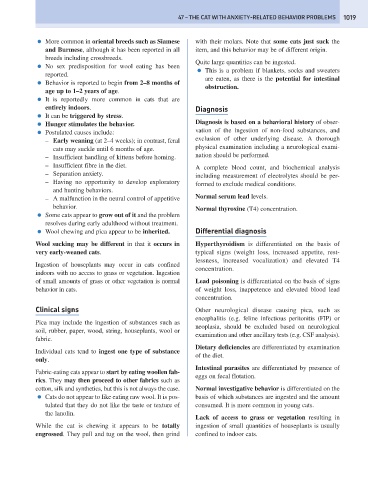Page 1027 - Problem-Based Feline Medicine
P. 1027
47 – THE CAT WITH ANXIETY-RELATED BEHAVIOR PROBLEMS 1019
● More common in oriental breeds such as Siamese with their molars. Note that some cats just suck the
and Burmese, although it has been reported in all item, and this behavior may be of different origin.
breeds including crossbreeds.
Quite large quantities can be ingested.
● No sex predisposition for wool eating has been
● This is a problem if blankets, socks and sweaters
reported.
are eaten, as there is the potential for intestinal
● Behavior is reported to begin from 2–8 months of
obstruction.
age up to 1–2 years of age.
● It is reportedly more common in cats that are
entirely indoors. Diagnosis
● It can be triggered by stress.
● Hunger stimulates the behavior. Diagnosis is based on a behavioral history of obser-
● Postulated causes include: vation of the ingestion of non-food substances, and
– Early weaning (at 2–4 weeks); in contrast, feral exclusion of other underlying disease. A thorough
cats may suckle until 6 months of age. physical examination including a neurological exami-
– Insufficient handling of kittens before homing. nation should be performed.
– Insufficient fibre in the diet. A complete blood count, and biochemical analysis
– Separation anxiety. including measurement of electrolytes should be per-
– Having no opportunity to develop exploratory formed to exclude medical conditions.
and hunting behaviors.
– A malfunction in the neural control of appetitive Normal serum lead levels.
behavior. Normal thyroxine (T4) concentration.
● Some cats appear to grow out of it and the problem
resolves during early adulthood without treatment.
● Wool chewing and pica appear to be inherited. Differential diagnosis
Wool sucking may be different in that it occurs in Hyperthyroidism is differentiated on the basis of
very early-weaned cats. typical signs (weight loss, increased appetite, rest-
lessness, increased vocalization) and elevated T4
Ingestion of houseplants may occur in cats confined
concentration.
indoors with no access to grass or vegetation. Ingestion
of small amounts of grass or other vegetation is normal Lead poisoning is differentiated on the basis of signs
behavior in cats. of weight loss, inappetence and elevated blood lead
concentration.
Clinical signs Other neurological disease causing pica, such as
encephalitis (e.g. feline infectious peritonitis (FIP) or
Pica may include the ingestion of substances such as
neoplasia, should be excluded based on neurological
soil, rubber, paper, wood, string, houseplants, wool or
examination and other ancillary tests (e.g. CSF analysis).
fabric.
Dietary deficiencies are differentiated by examination
Individual cats tend to ingest one type of substance
of the diet.
only.
Intestinal parasites are differentiated by presence of
Fabric-eating cats appear to start by eating woollen fab-
eggs on fecal flotation.
rics. They may then proceed to other fabrics such as
cotton, silk and synthetics, but this is not always the case. Normal investigative behavior is differentiated on the
● Cats do not appear to like eating raw wool. It is pos- basis of which substances are ingested and the amount
tulated that they do not like the taste or texture of consumed. It is more common in young cats.
the lanolin.
Lack of access to grass or vegetation resulting in
While the cat is chewing it appears to be totally ingestion of small quantities of houseplants is usually
engrossed. They pull and tug on the wool, then grind confined to indoor cats.

